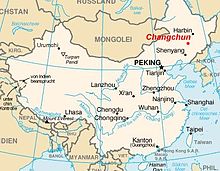Changchun
![]()
This article is about the capital of Jilin Province in the northeast of the People's Republic of China. For other meanings see Changchun (disambiguation).
Changchun (Chinese 長春市 / 长春市, pinyin Chángchūn Shì - "long spring") is the capital of Jilin Province in the northeast of the People's Republic of China and one of the country's 15 sub-provincial cities. It has about 3.4 million inhabitants in the city center (as of January 1, 2010) and about 7.7 million in the entire metropolitan area.
![]()
This article or section needs a revision: In 2020, a part of Siping was transferred to Changchun with Gongzhuling. The figures in this article are therefore not only old and therefore no longer up to date, but also no longer describe the current substance.
Please help to improve it and remove this mark afterwards.

Location of Changchun in China
Geography
Surface and climate
The administrative area of Changchun covers an area of 20,565 km².
The average annual temperature is 4.9 °C, the annual precipitation total 616 mm. The climate is continental with cold and relatively dry winters and warm and humid summers.
| Monthly average temperatures and precipitation for Changchun
Source: wetterkontor.de | ||||||||||||||||||||||||||||||||||||||||||||||||||||||||||||||||||||||||||||||||||||||||||||||||||||||||||||||||||||||||||||||||||||||||||||||||||||||||||||||||||||||||||||||||||||||||||||||||||||||||||||||||||||||||||||||
Administrative structure
At the county level, Changchun is composed of seven urban districts, one county and three independent cities. These are:
- Chaoyang Municipality (朝阳区), 379 km², population 740,000, center, seat of municipal government;
- Erdao Municipality (二道区), 965 km², population 390,000;
- Jiutai Municipality (九台区), 2,875 km², population 830,000;
- Kuancheng Municipality (宽城区), 877 km², population 470,000,
- Lüyuan Municipality (绿园区), 301 km², population 570,000;
- Nanguan Municipality (南关区), 497 km², population 610,000,
- Shuangyang Municipality (双阳区), 1,663 km², population 380,000;
- Nong'an County (农安县), 5,221 km², population 1.12 million, capital: Nong'an Metropolitan Municipality (农安镇);
- Dehui city (德惠市), 3,096 sq km, population 920,000;
- Gongzhuling city (公主岭市), 4,060 sq km, population 1,040,000;
- Yushu city (榆树市), 4,691 sq km, population 1.23 million.
The population figures refer to the end of 2004 and assume a population of 7.26 million for the whole of Changchun at that time.
Population
The 2000 census counted a population of 7,135,439 for the entire Changchun administrative area.
| Name of the people | Inhabitants | Share (in percent) |
| Han | 6.883.310 | 96,47 |
| Manju | 0142.998 | 02,0 |
| Korean | 0049.588 | 00,69 |
| Hui | 0043.692 | 00,61 |
| Mongolian | 0011.106 | 00,16 |
| Xibe | 00000685 | 00,01 |
| Zhuang | 00000533 | 00,01 |
| Miao | 00000522 | 00,01 |
| Other | 00003.005 | 00,04 |
Population development of the agglomeration according to UN
In 2017, just under 4.2 million inhabitants lived in the actual urban settlement area of the city. The remaining population lives in the rural hinterland. Due to advancing urbanisation, 5.5 million inhabitants are expected to live in the agglomeration by 2035.
| Year | Population |
| 1950 | 765.000 |
| 1960 | 1.111.000 |
| 1970 | 1.255.000 |
| 1980 | 1.655.000 |
| 1990 | 2.350.000 |
| 2000 | 2.892.000 |
| 2010 | 3.577.000 |
| 2017 | 4.152.000 |
Economy
Changchun is one of the most important industrial cities in northern China. The city is home to steel mills and a large number of metal processing plants. The number 1 vehicle plant (China FAW Group) was once the largest manufacturer of cars in China and has been operating two large joint ventures in the city together with Volkswagen/Audi and Toyota since 1991. In 2004, vehicle plant number 2 was inaugurated. It produces 660,000 VW vehicles a year and employs 9,000 people at its vehicle plants. A further expansion stage to become China's largest car city is planned. Changchun has also had its own international motor show since 1999. The China Changchun International Automobile Fair 2009 was the largest event to date with 130 domestic and foreign exhibitors. But the car manufacturer Zxauto also operates its second plant here.
Other economic factors are
- agriculture: the Changchun area covers 1.1 million hectares of cultivated land;
- the film industry: since 1992, the Changchun Film Festival has been held and
- rail transport: Changchun is an important rail hub, with connections to Russia, Korea and numerous Chinese provinces. The Beijing-Harbin and Dalian-Harbin high-speed rail links currently under construction will pass through Changchun.
According to a study from 2014, Changchun generated a gross domestic product of 124.46 billion US dollars in purchasing power parity. In the ranking of the economically strongest metropolitan regions worldwide, it thus ranked 108th. The GDP per capita is US$16,413 (KKB). GDP per capita grew at an average annual rate of 12.4% from 2000 to 2014.
Search within the encyclopedia